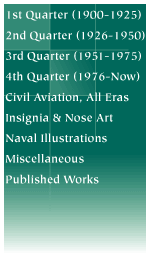
![]()

The Gloster Meteor F.8 & FR.9
By Chris Banyai-Riepl
The Gloster Meteor was Britain's first operational jet fighter. Unlike most other first jets, though, the Meteor managed to survive the Second World War and continue on for many years to come. Fighting in the Korean Conflict in the early 1950s and in the Suez Crisis in the mid-1950's, the Meteor proved its worth time and again. In addition to being an effective fighting platform, the Meteor flew in some of the most colorful schemes out there, some of which are depicted here.

Meteor F.8 WA785
Squadron Commander
No. 66 Squadron, 1954
This Meteor F.8 carries the usual fuselage bars of No. 66 Squadron, but the tail has been painted up to make the commander's plane stand out from all the rest. The tail is painted in the same colors and form as the fuselage bars, being white outlined in blue.

Meteor F.8 WH374
No. 63 Squadron, 1952-1955
Who's imitating who I don't know, but along the same lines as the No. 66 Sqn bird is this No. 63 Sqn Meteor, with black and yellow checks on the tail matching the fuselage bars. Many of these colorful Meteors were painted up specially for the RAF Coronation Review in July of 1953.

Meteor F.8 A77-446
"Black Murray"
No. 77 Squadron
RAAF, Korea, 1950-1953
The Australians took the Meteor into combat during the Korean conflict. There are a couple differences between the Australian and RAF Meteors depicted here, being the canopy and the radio compass fairing. Several Australian Meteors were named, with the most famous being "Halestorm", the MiG Killer flown by Sergeant George Hale.

Meteor F.8 4441
No. 1 Grupo
Brazilian Air Force, 1955
Going farther away from most Meteor operators, Brazil operated about sixty Meteors for many years, eventually being replaced by Mirage IIIs. Easily one of the most colorful Meteors out there, the Brazilian Meteors carried red trim, and lots of it. Coupled with the large squadron emblem and the green and yellow national markings, this plane definitely stood out!
The Meteor didn't spend all of its time in a shiny silver finish, though. Camouflage is essential to survival in a combat situation, and the Meteor wore camouflage from day one. But if camouflage is so essential, why did the British put such large and colorful squadron markings on their planes? Ah, well, no matter, as it gives us something neat to build models of!

Meteor F.8 VZ467
"Winston"
This is an interesting Meteor example with a long and varied history. It has the distinction of being the last flying Meteor F.8, and is painted up to represent 615 (County of Surrey) Squadron RAuxAF. It was supposed to partake in a flypast celebrating Winston Churchill's birthday at some point in the 1970s, but because of the fuel crisis the flypast never took place. For a more detailed history, check out the article on the Czech Master Resin 1/72 Meteor F.8 by Damien Burke in the August 1999 issue of Internet Modeler.

Meteor FR.9 WX978 'Z'
No. 8 Squadron
Middle East, 1959
A weathered example of the Meteor FR.9, this plane shows off the blue undersurfaces carried by the FR Meteors. The unit flash consisted of a chevron divided horizontally with sand, red, and blue bands. The white "Z" on the tail is outlined in red.

Meteor FR.9 XZ608
No. 208 Squadron
Aden, 1956
This is an interesting FR.9 seen at Aden around 1956. The typical markings of No. 208 Squadron can be seen, with the yellow nose and the blue/yellow/blue fuselage bands. The unique part is in the white sections covering the engine, nose, and rear fuselage. There is some confusion to these markings, as they were originally identified as being orange in the photo I based this profile from. The theory was that they were painted orange to aid in visibility if the plane went down in the desert. However, the specific locations of the overpainted areas made me suspicious. After looking at what is under these areas on the Meteor FR.9, I concluded that these areas were painted white to reflect heat away from the cameras, engines, and radio equipment. If anyone has a definite answer to this, please let me know.

Meteor F.8 412
Syrian Air Force, 1956
Another foreign user of the Meteor was Syria, who flew F.8s during the Suez Crisis of 1956. Camouflaged in brown and green over a light gray, the Syrian Meteors even managed to see action during the conflict, with an RAF PR Canberra being shot down by a Syrian Meteor on November 6, 1956.